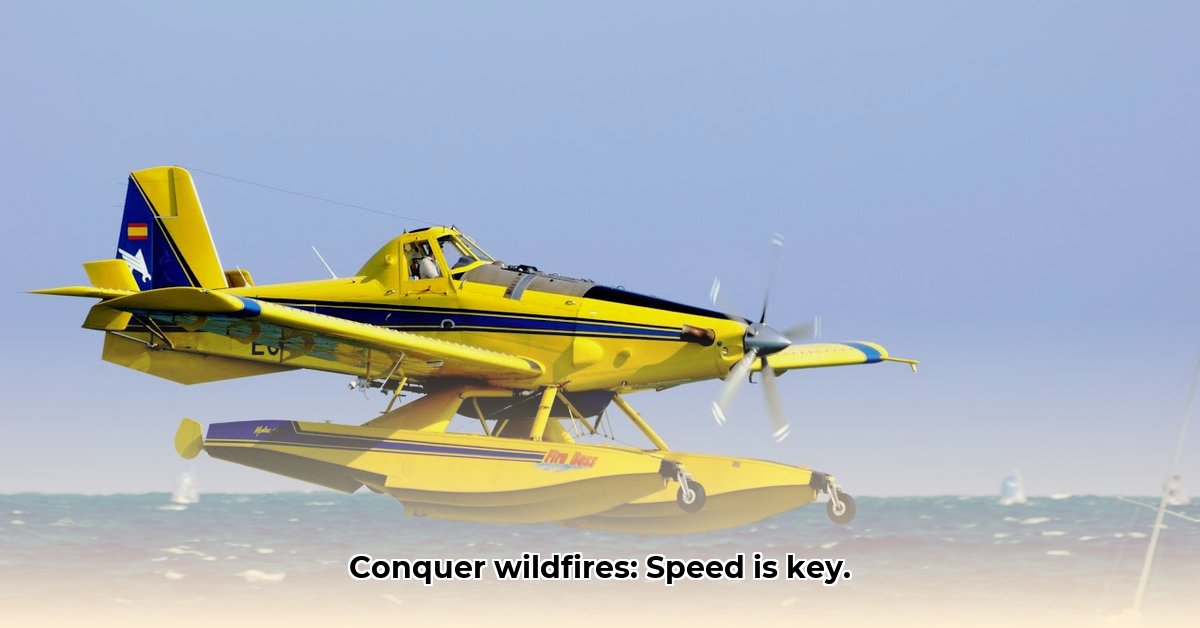
Air Tractor AT-802 Fire Boss: A Game Changer in Wildfire Response
The Air Tractor AT-802 Fire Boss is a specialized aerial firefighting aircraft designed for speed and efficiency in wildfire suppression. Its unique capabilities are revolutionizing how we combat raging infernos. This article will explore its key features, operational capabilities, and advantages, while also addressing areas needing further investigation. For more in-depth information, check out this dedicated webpage: Fire Boss Specs.
Unmatched Speed and Payload Capacity
The Fire Boss's most striking feature is its incredibly fast refueling speed. It can scoop up approximately 817 gallons of water in just 30 seconds, allowing for rapid turnaround times – often under five minutes – before returning to the fire. This rapid response dramatically increases the number of water drops per hour, significantly enhancing firefighting efficiency. Furthermore, its substantial payload capacity—between 600 and 820 gallons, depending on factors like fuel load and configuration—ensures each water drop delivers a powerful impact on the fire's spread. Isn't the ability to deliver such significant water volume in such a short timeframe a key factor in wildfire suppression success?
Operational Capabilities and Maneuverability
The Fire Boss's operational capabilities go beyond simply carrying and dropping water. Its exceptional maneuverability is a critical asset, especially in challenging terrain. It can navigate mountainous regions and access difficult-to-reach fire zones effectively, significantly expanding its operational reach. The ability to take off and land from short, improvised runways—on land or water—further enhances its versatility and makes it incredibly responsive in emergency situations. This agile performance offers a notable advantage over larger aircraft that may struggle in complex terrain.
Advantages, Disadvantages, and Cost Considerations
The AT-802 Fire Boss presents several key advantages: unparalleled refueling speed, impressive payload capacity, exceptional maneuverability, and comprehensive safety features (including an advanced engine warning system and emergency hopper overflow system). However, a comprehensive analysis of operational costs, encompassing fuel consumption and maintenance, requires further research. While preliminary observations suggest potential cost-effectiveness due to high efficiency, definitive conclusions require more detailed data analysis. This lack of readily available cost data presents a limitation in fully assessing its overall economic viability.
A Comparison with Other Aerial Firefighting Aircraft
While a detailed comparison is beyond the scope of this article, preliminary assessments suggest the Fire Boss's unique combination of speed, payload, and maneuverability positions it favorably against many other aerial firefighting aircraft. Its advantages are particularly significant in situations demanding rapid response and precision in challenging terrain.
Conclusion: The Future of Wildfire Control
The Air Tractor AT-802 Fire Boss represents a significant advancement in aerial firefighting technology. Its speed, payload capacity, and maneuverability offer a game-changing advantage in controlling wildfires. Continued research, particularly focusing on operational costs, is key to fully understanding its long-term impact and economic viability. However, the Fire Boss's capabilities already suggest a pivotal role in shaping the future of wildfire suppression.
How to Reduce Operational Costs of the Air Tractor AT-802 Fire Boss
Optimizing the operational efficiency of the AT-802 Fire Boss is crucial for cost reduction. Several strategies can be implemented:
- Optimize Fuel Consumption: Implement efficient flight planning, ensure peak engine performance through regular maintenance, and provide pilot training focused on fuel-efficient flight techniques.
- Minimize Downtime: Implement a robust preventative maintenance schedule, including regular inspections and proactive component replacements. This significantly reduces costly unscheduled maintenance.
- Strategic Resource Allocation: Efficiently manage pilot hours, optimize the number of aircraft dispatched per fire, and ensure the most suitable aircraft is deployed based on fire conditions. Coordination with ground crews is essential.
- Leverage Technological Advancements: Utilize GPS-guided systems for increased precision, real-time data analysis for efficient resource allocation, and predictive maintenance using sensors.
- Negotiate Favorable Contracts: Secure cost-effective agreements with fuel suppliers, maintenance providers, and insurance companies.
- Explore Alternative Retardants: Investigate cost-effective and environmentally friendly retardants to reduce both expenses and environmental impact.
- Improve Pilot Training and Retention: Invest in comprehensive training and create a supportive work environment to retain experienced pilots and minimize training costs from frequent turnover.